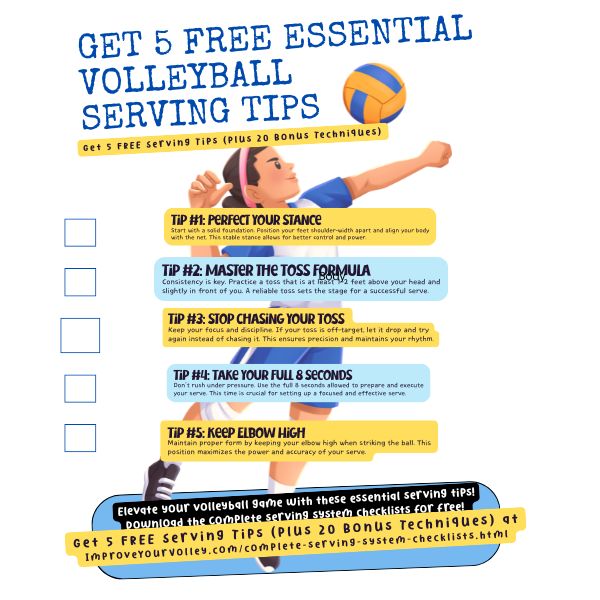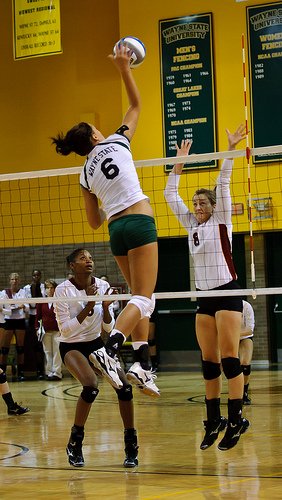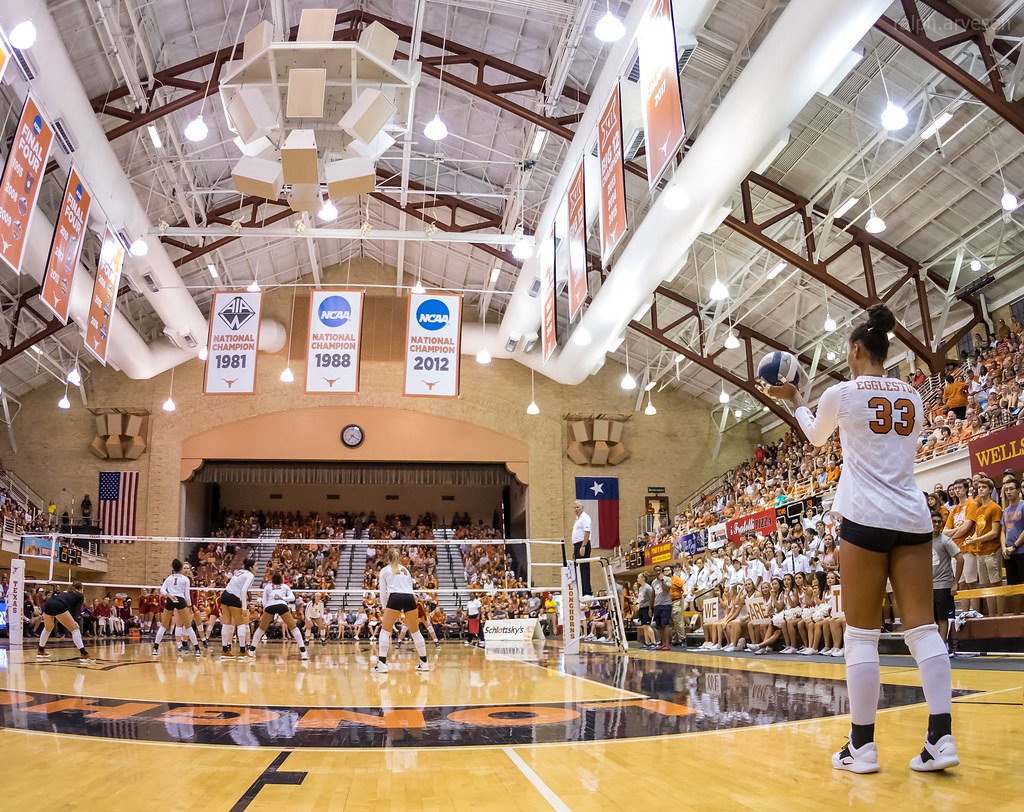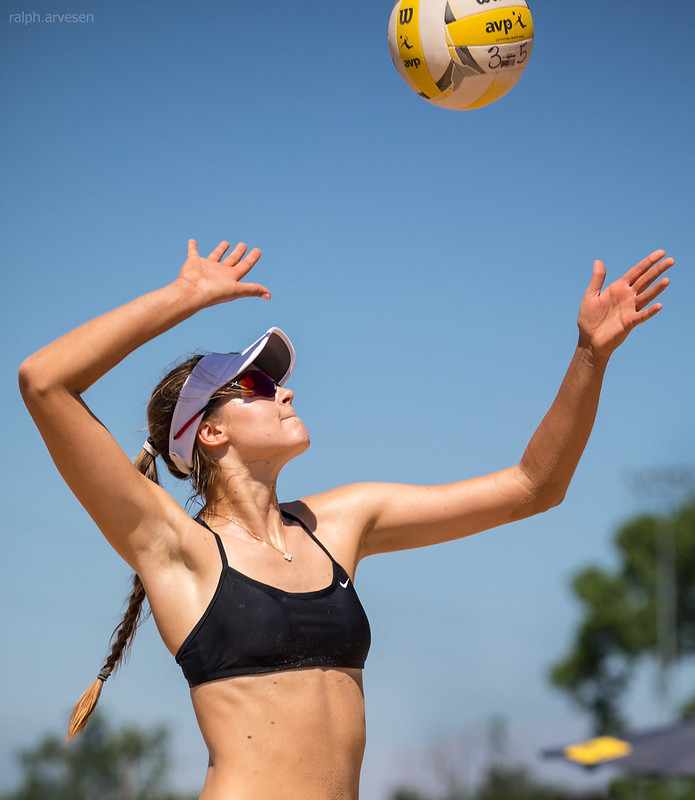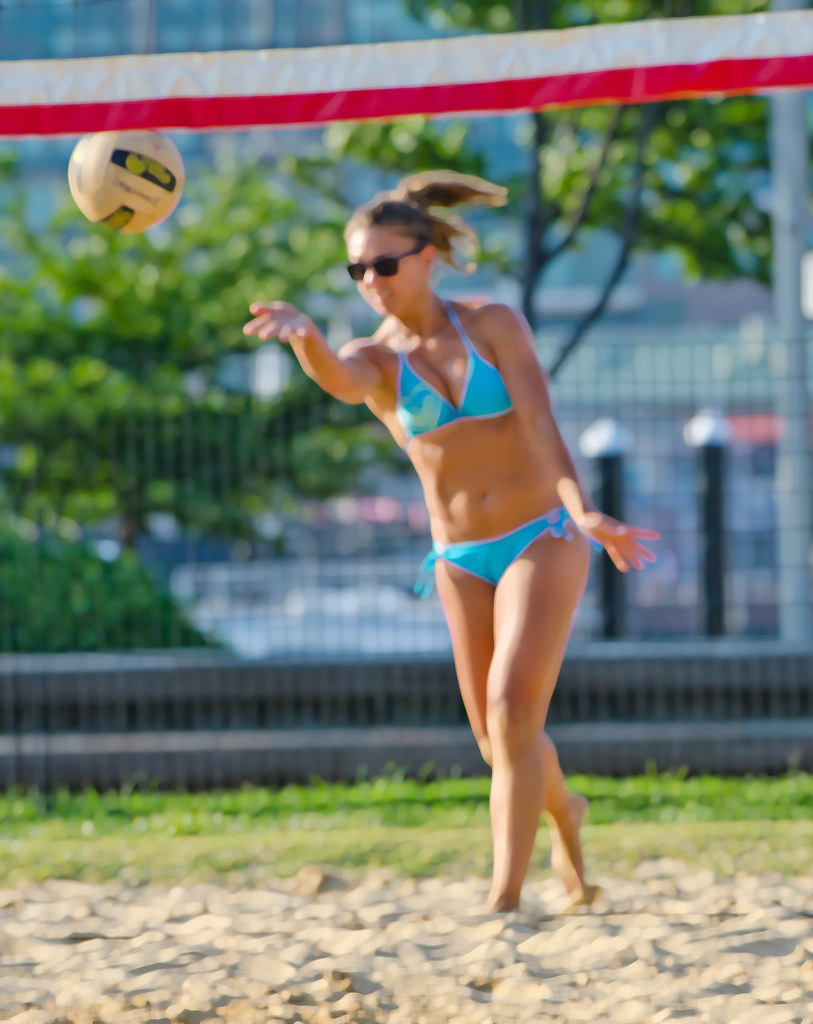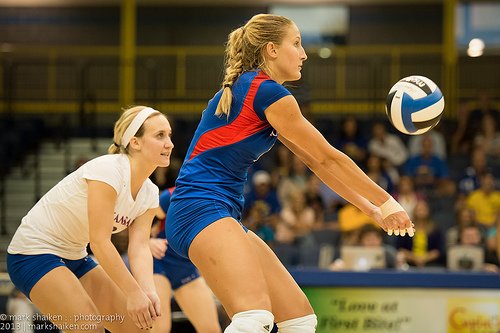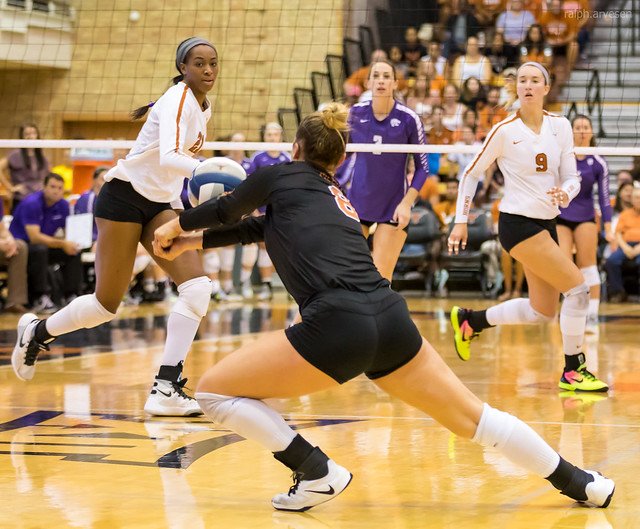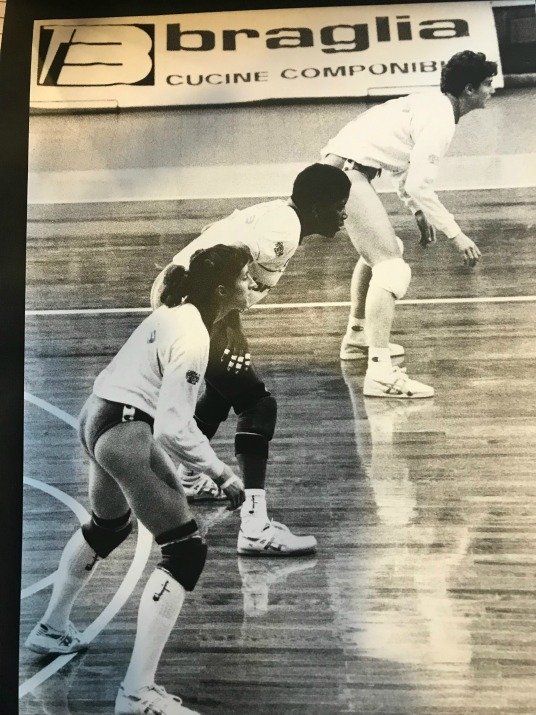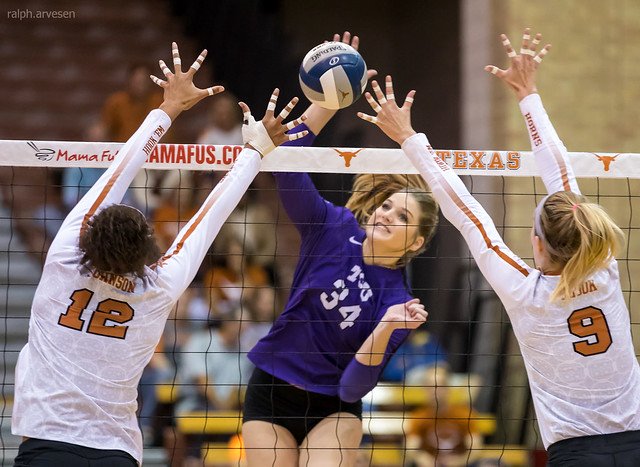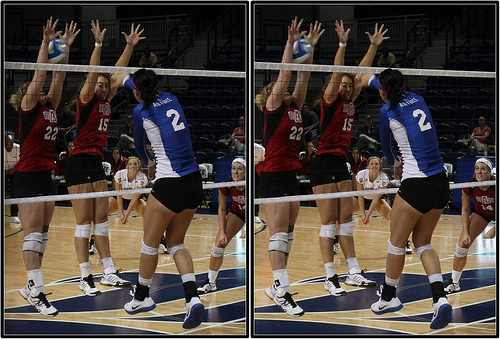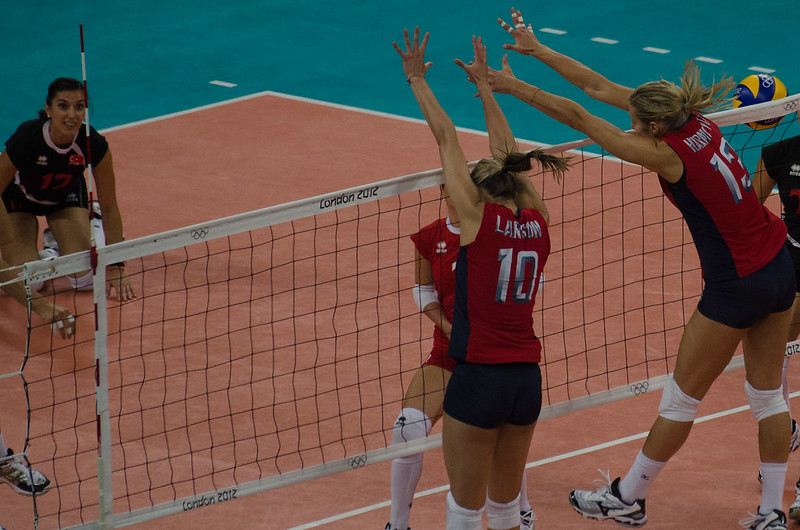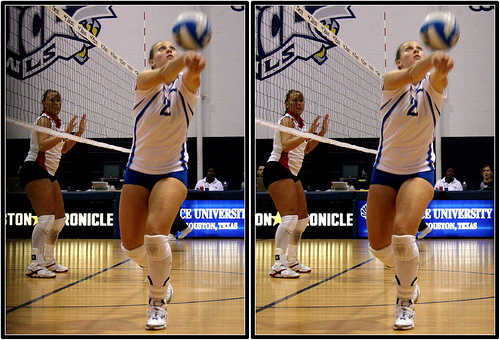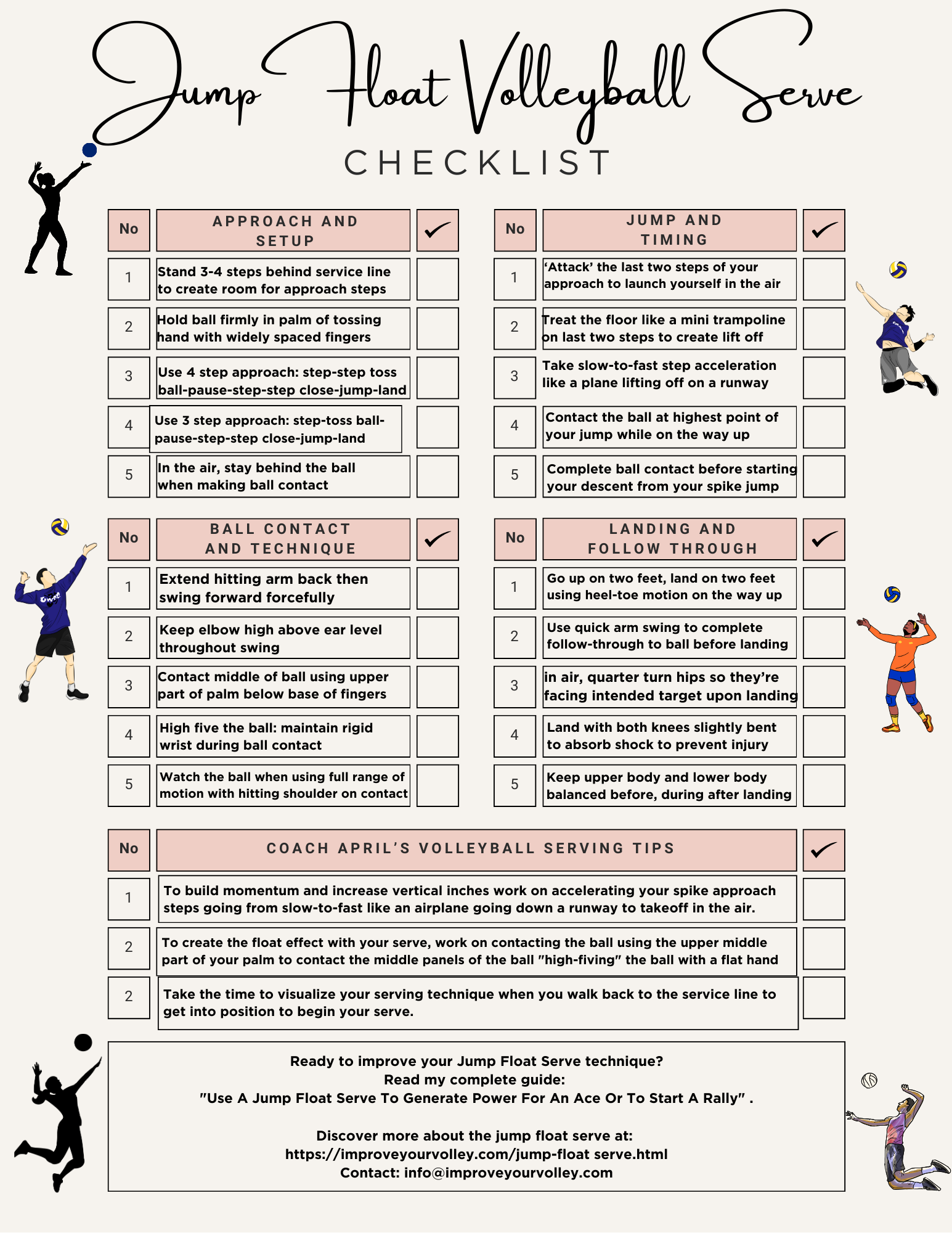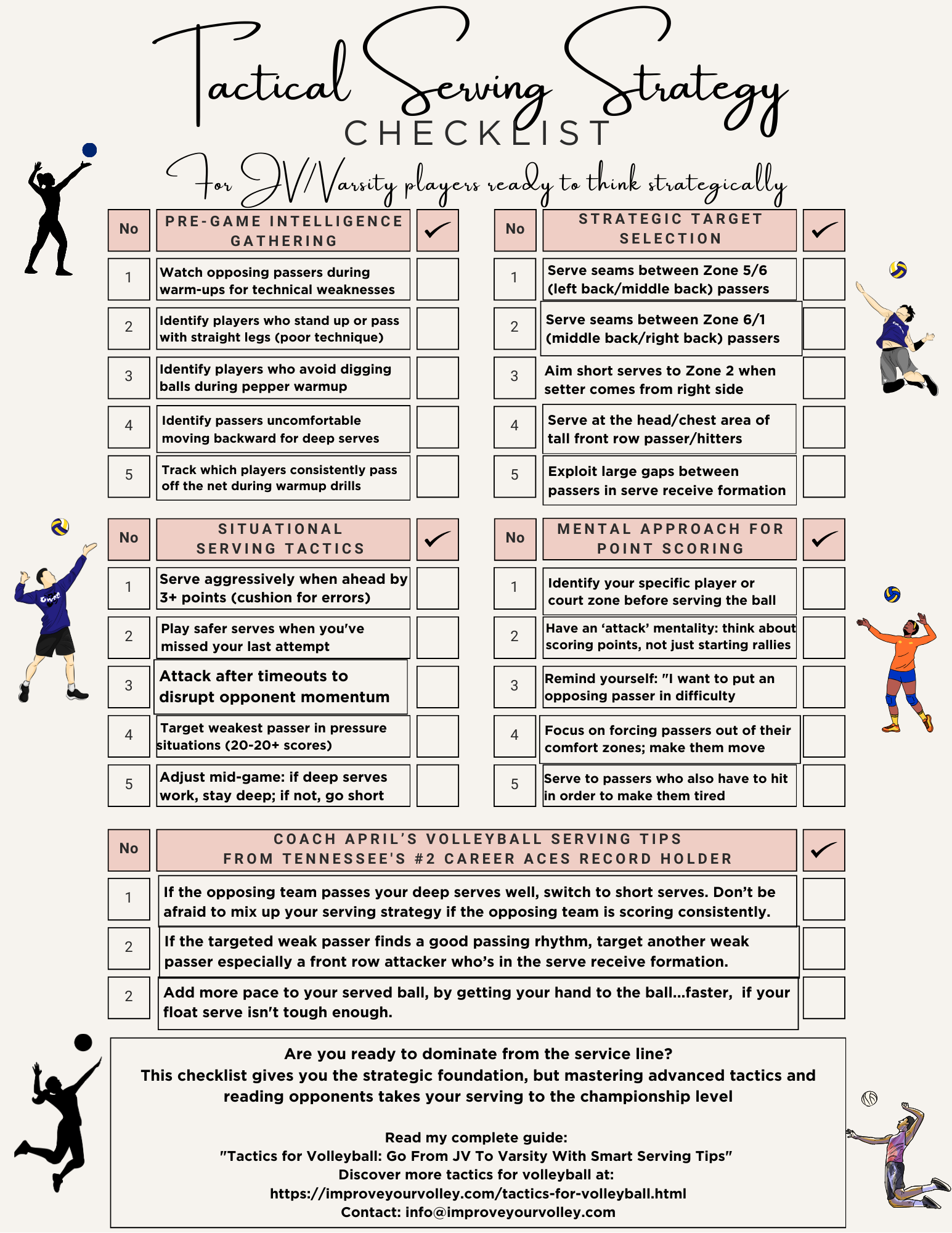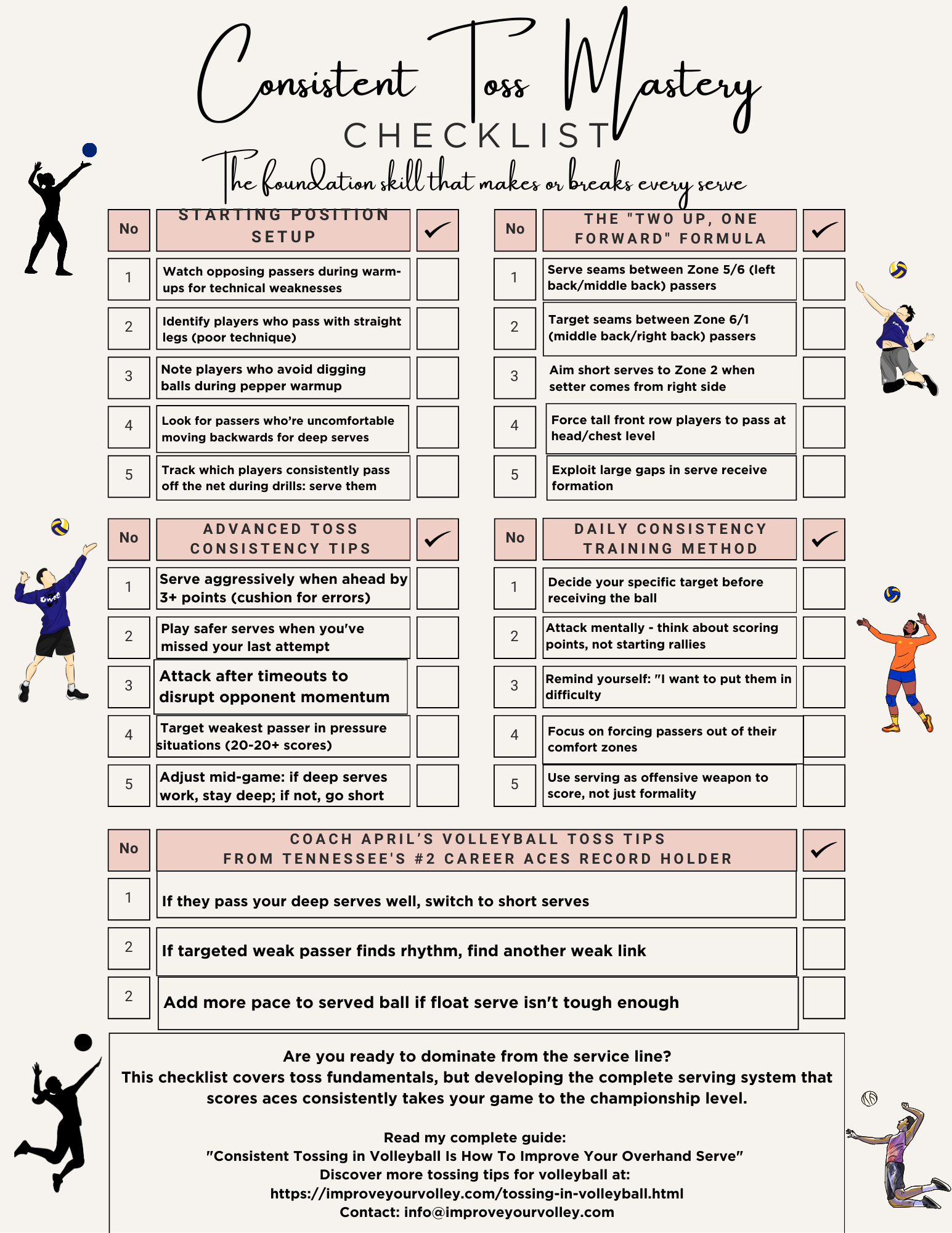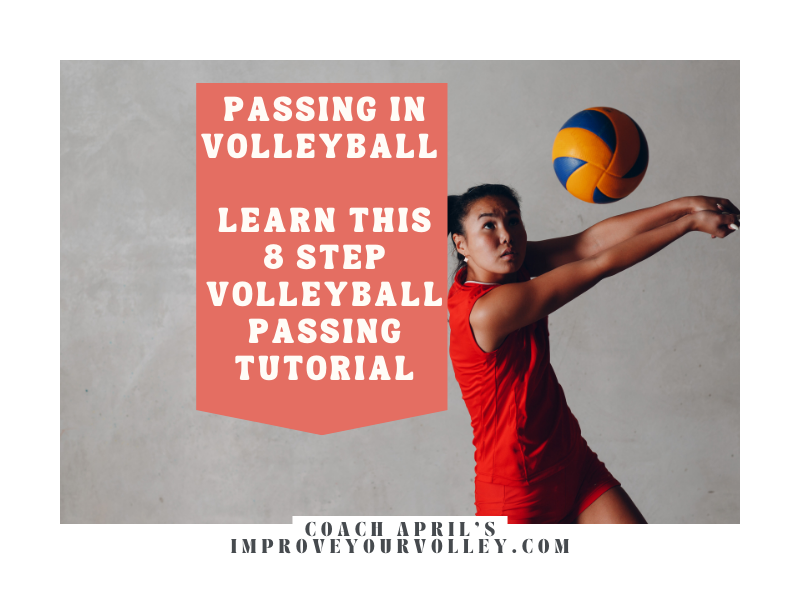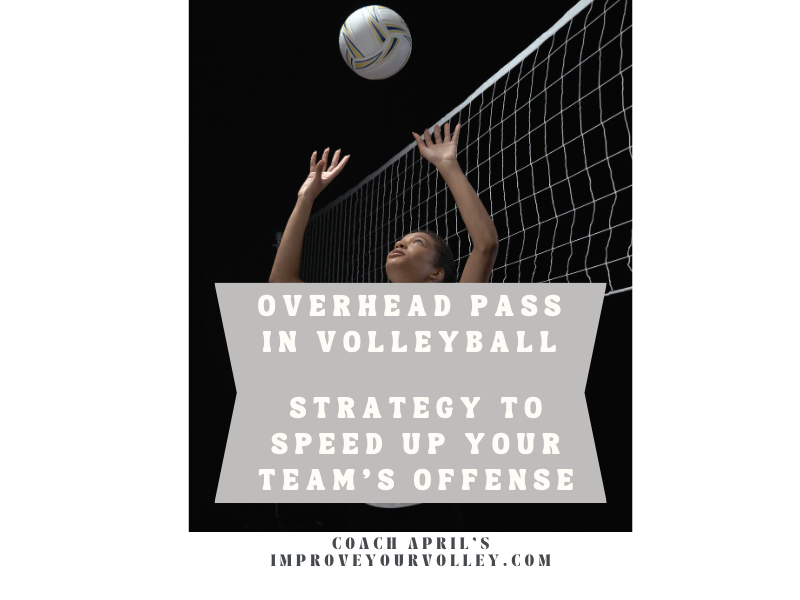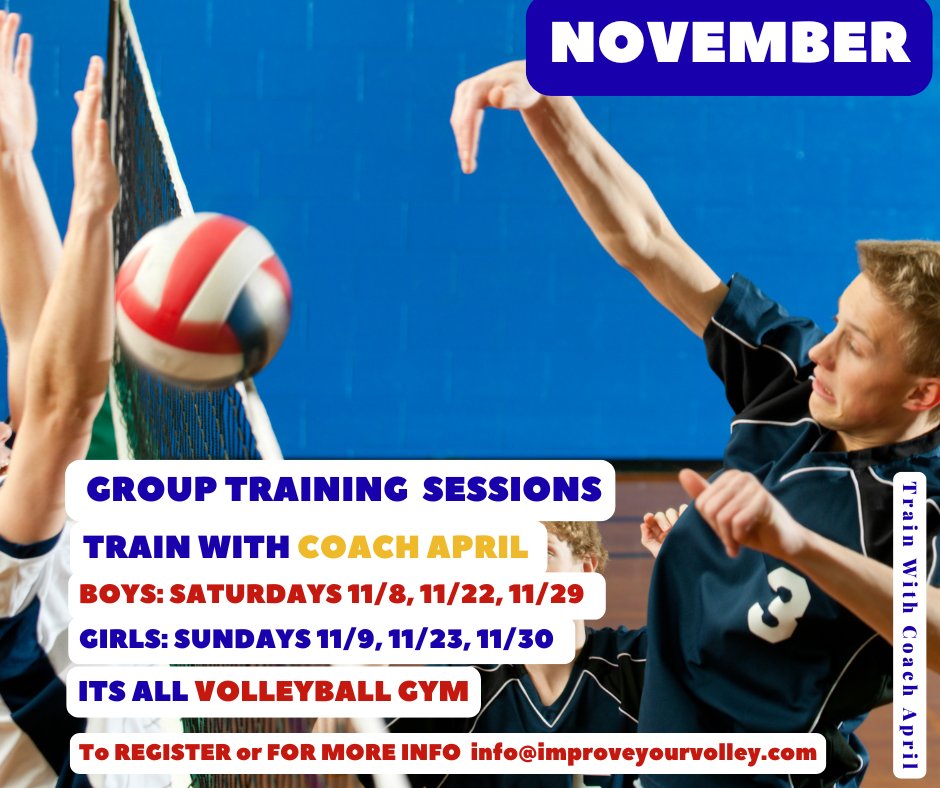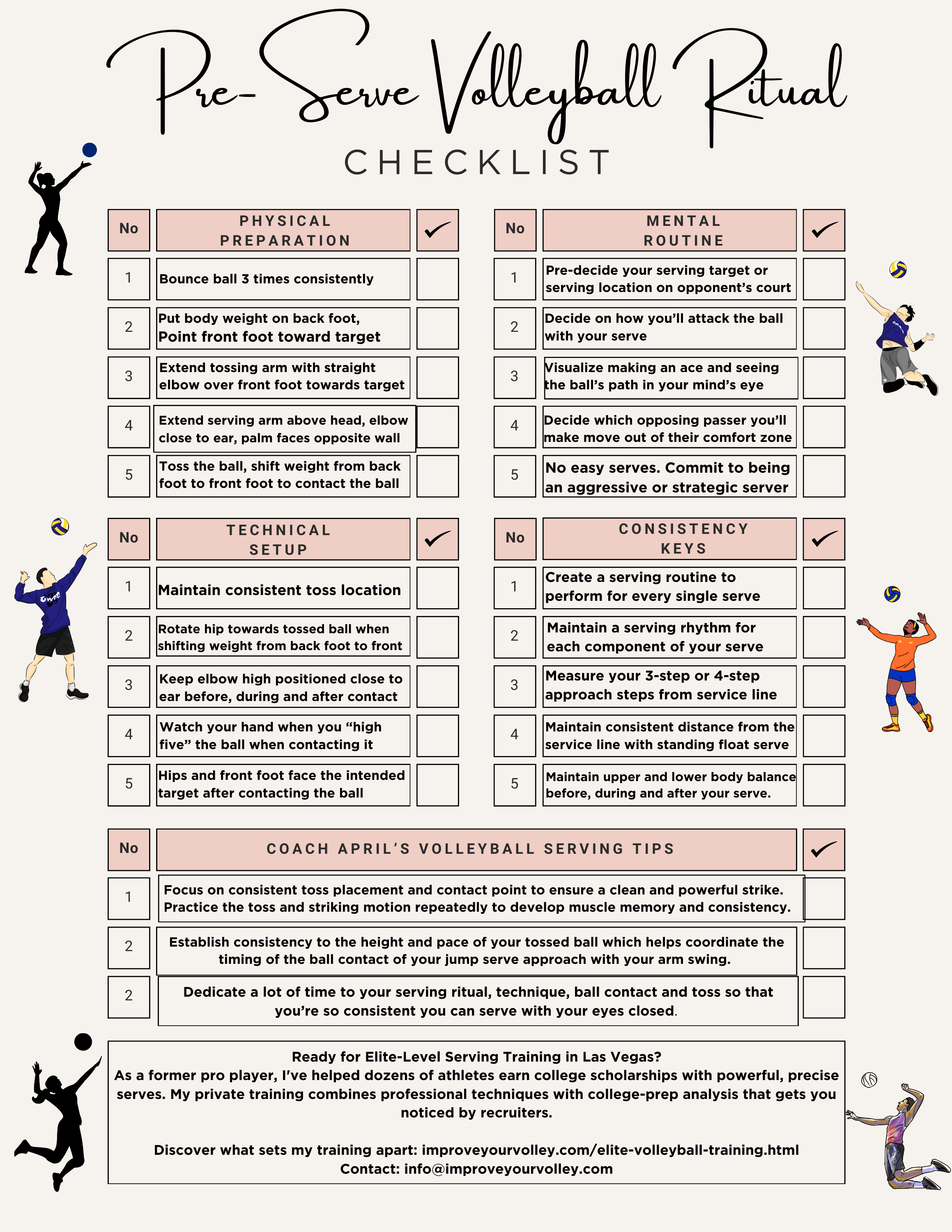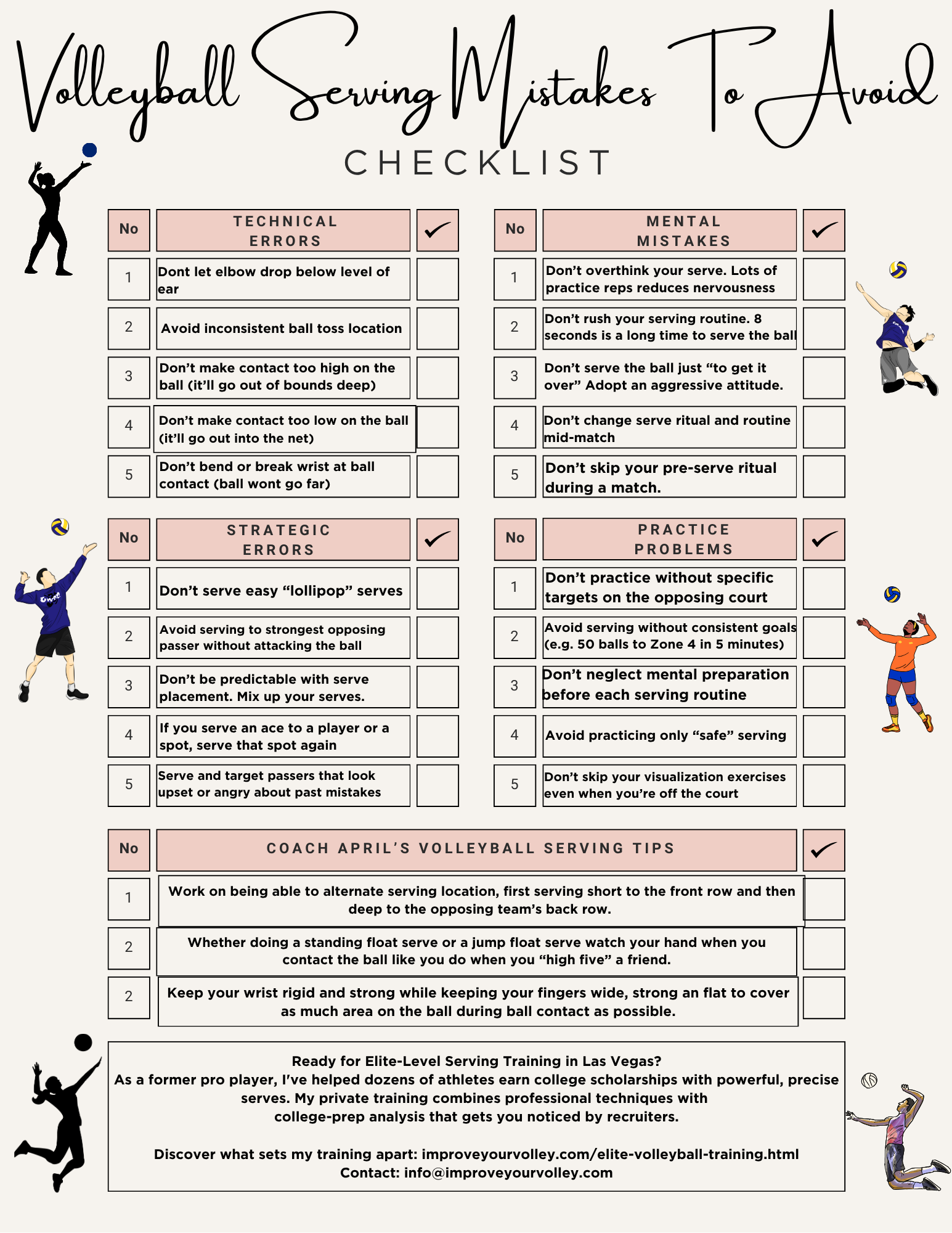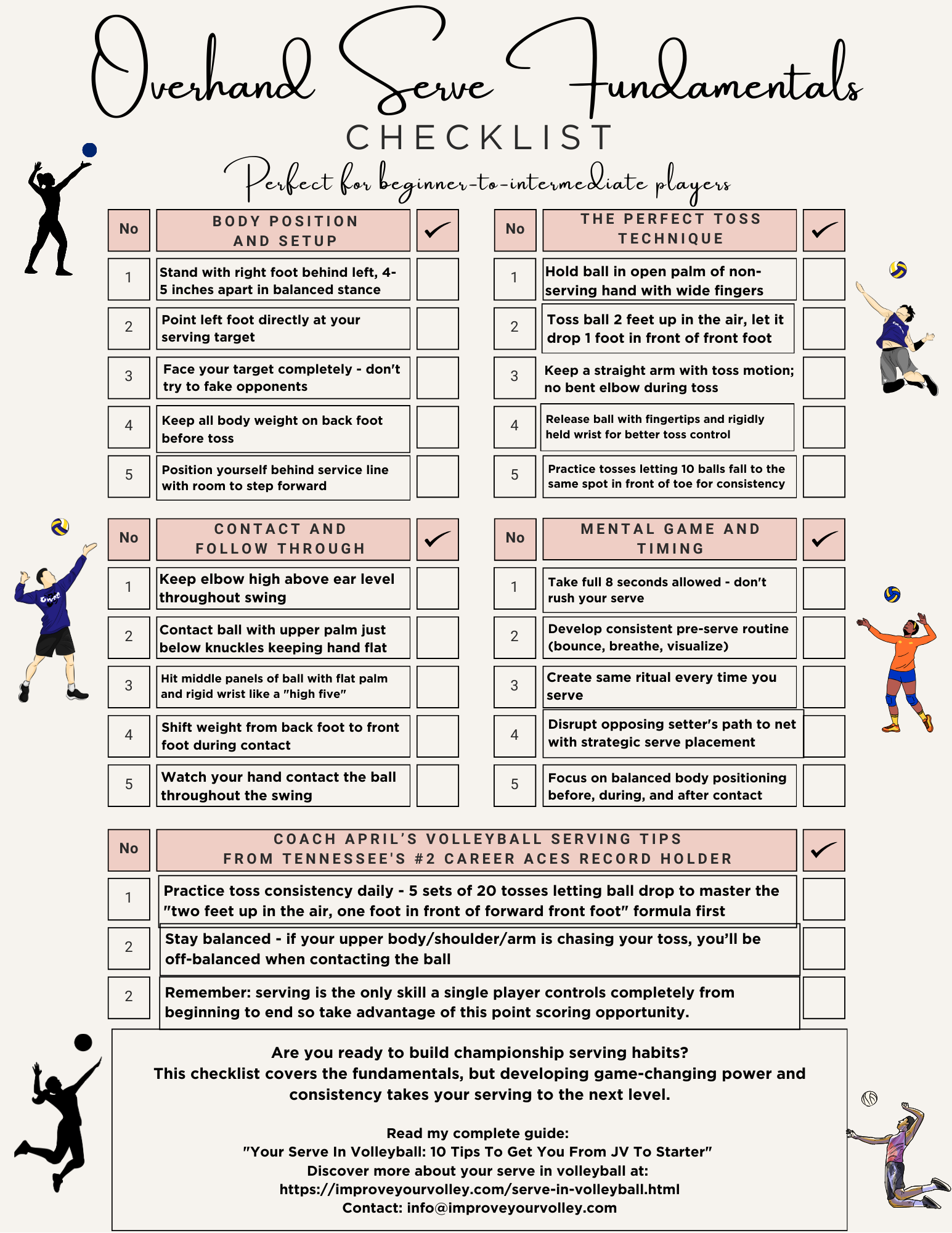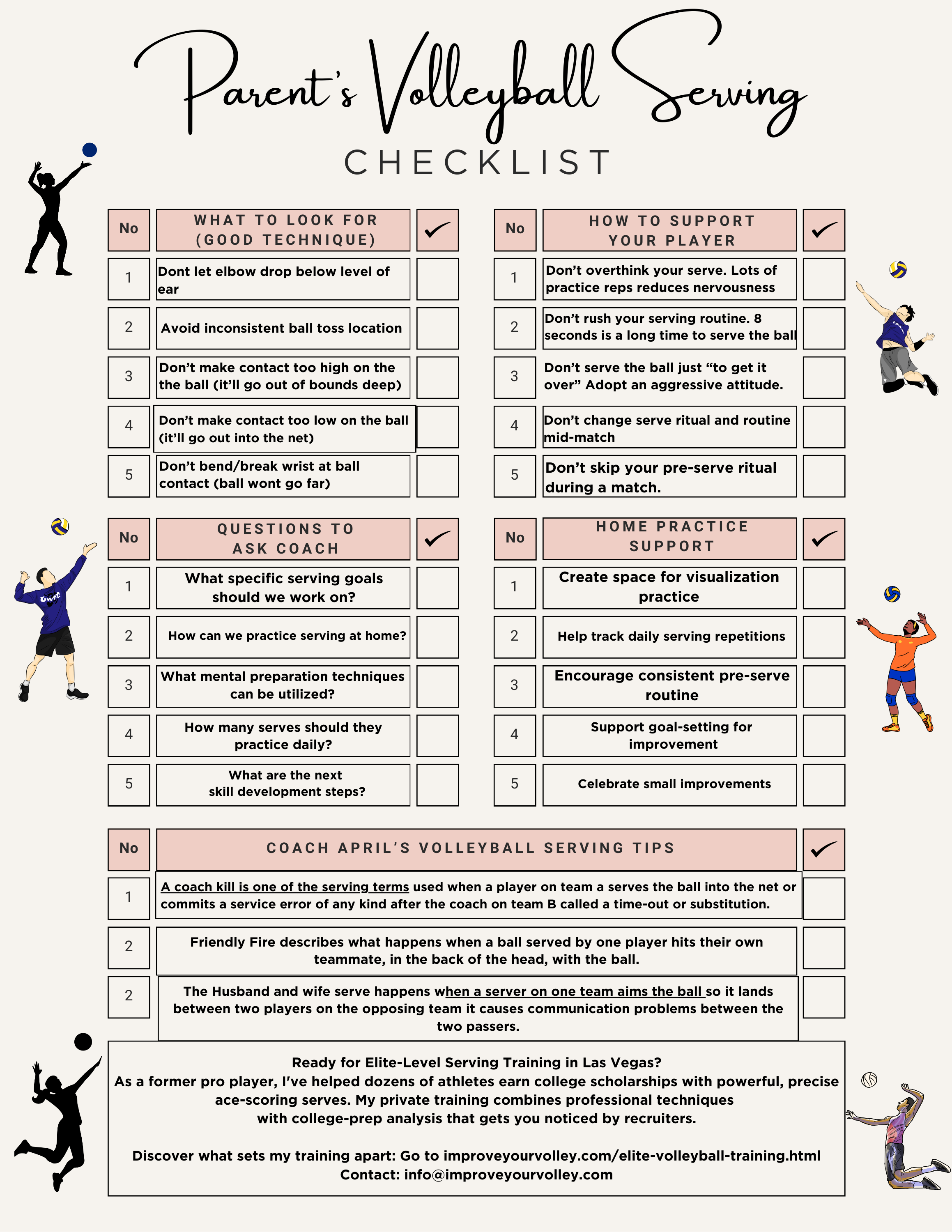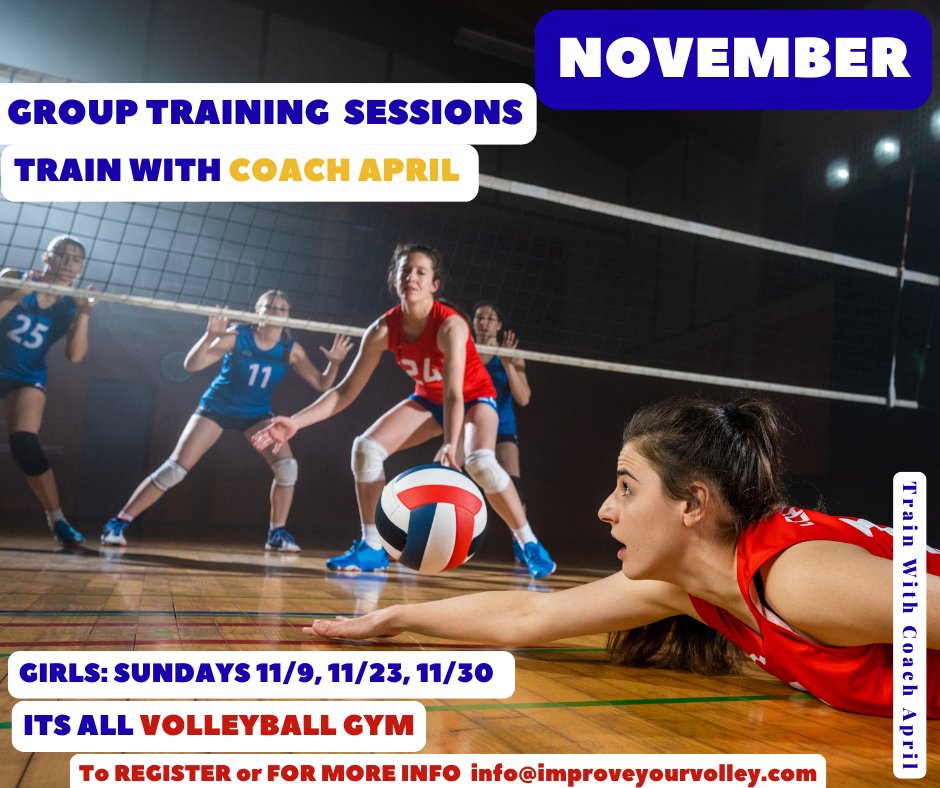- Improve Your Volleyball with Coach April
- The Libero Volleyball Position FAQs
- Basic Skills In Volleyball
Beginner Players Must Learn The 6 Basic Skills In Volleyball First
Beginner players looking to learn how to perform all six of the basic skills in volleyball serving, passing, setting, digging, hitting and blocking start here.
Okay beginners...so lets start with the basics in volleyball which are in order of importance
- serving
- passing
- hitting
- setting
- blocking
- digging
In this section, which I've dedicated to beginner players..you'll find a directory of all the basic skills in volleyball, basic rules, basic drills and all the basic information that a player needs to know, to learn to study in order to improve their skills so they move from freshman team to JV team to varsity team.
Basic Skills in Volleyball
If you can't serve, you can't play.
In this section I put the beginner basic information about every type of of serve that you'll need to know about.
From the specifics about the toss for the float serve, to how to underhand serve, to an introduction to more advanced serves like the top spin and jump float serve to understanding what a let serve is.
Hint: the let serve is a serving rule you should know as a freshman player.
Volleyball Serving Rules What Are The Rules When Serving A Volleyball?
Each official match must
- begin with a serve from one team on defense which
- is launched into the court of the opposing team who's receiving serve
- by a player in their service area behind the end line
- with the intent on starting the rally and possibly scoring a point
Click to go to the page with the rest of the article information.
Service In Volleyball Who What When Where Why and How To Serve A Ball
The volleyball serve skill is used by a player to launch the ball over the net to start a rally.
The serve puts the ball in play once the referee blows the first whistle.
Before the first set of the match the team that wins the coin toss is the team that gets to serve first.
Click to go to the page with the rest of the article information.
The Volleyball Toss How Consistent Is Your Ball Toss Before You Serve?
Your volleyball toss for the overhand must be consistent regardless of what serving style you choose…but especially important for the standing float serve.
You have to learn to toss the volleyball ball the same way, …at the same height, putting the ball in the same spot every single time.
Click to go to the page with the rest of the article information.
The Underhand Volleyball Serve How Should A Beginner Serve The Basics
Here's a ten-step underhand volleyball serve checklist for beginner players.
Click to go to the page with the rest of the article information.
Basic Skills in Volleyball
Passing is the most important skill.
Many people think that passing is the most important of the six basic skills in volleyball.
3 Volleyball Forearm Pass Cues On What To Do With Arms, Feet And Hips
There are three volleyball forearm pass cues you should use to improve your passing skills, keep your arms together, feet grounded and hips behind the ball.
- keep your arms together
- keep both feet on the ground
- move quickly to position yourself behind the ball
Volleyball Passing Platform How Do You Make A Platform With Your Arms?
The digging and passing platform in volleyball is where the ball, after an attack hit, contacts your forearms to be deflected and/or redirected into the air usually towards the middle of the court towards the setter zone near the middle of the net.
What's The Correct Volleyball Ready Position For Passing in Volleyball
What is the ready position for passing in volleyball?
The four steps to passing in volleyball starts with a passer who adopts a volleyball stance for passing
- clasps your thumbs together keeping them side by side and pointed to the ground
- which creates a flat surface on your forearms above your wrists and below the insides of your elbows...
- used to guide/deflect and angle a ball after contacting its underside
to another player or over the net.
Click to go to the page with the rest of the article information.
Basic Skills in Volleyball
Learning to hit is a big deal because you score points for the team.
The volleyball spike approach for hitting is also called the spike approach and is done by a spiker who takes 3 or 4 steps to a ball in the air before hitting it.
The Volleyball Spike Approach For Hitting The 3 and 4 Step Approach
Step One of the Three Step Volleyball Approach
The directional step is the first of three...
- which you'd use to propel yourself closer to where you want to contact the ball...
- this is your directional step...and
- this should be the slower step you take...
For a quick review...
As a right handed hitter you'd
- step on your left foot first ...
- which you'd use to propel yourself closer to where you want to contact the ball...
- This is your directional step...and this should be the slower step you take..
Terms For Types of Volleyball Hits Like Kill, Spike, Hit, And Attack
These terms describe what its called when you hit a volleyball specifically the 'kill', 'spike', 'hit' and 'attack' which are 4 diff types of volleyball hits.
Basic Skills in Volleyball
Blocking at the net is the first line of defense.
A lot of players and high school coaches have difficulty deciding where the hands need to be while moving along the net to block a ball.
What's The Block in Volleyball: Where Do Blockers Place Their Hands?
When you block in volleyball just what should you do with your hands?
Four Volleyball Blocking Tips These're Basic Rules for Better Blocking
Blocking is the first line of defense.
To block well you are required to
- have good footwork
- have great body control while moving laterally and vertically
- read your hitter to anticipate where and how she plans to attack
- penetrate your hands over the net to block the ball by deflecting it back into your opponents court
To learn what is legal and what common fouls and faults are allowed in the game read this article about volleyball blocking tips.
Basic Skills in Volleyball
Digging the ball sometimes means you have to hit the floor.
The dig is the last line of defense for a team to keep an opposing team's attack from scoring points by keep the ball off the floor.
A Volleyball Dig Technique We Use In Defense Is Called The Barrel Roll
To dig a volleyball that's more than 2-3 steps away from you and low to the floor, you need to know
- how to play balls up on the move, then
- complete your digging action and
- fall to the ground in a safe way that you get back up and keep playing without getting hurt.
Defensive Volleyball Plays: When Do You Dig A Ball Playing On Defense?
Defensive plays are made in a rally, after a team serves, the serving team is on defense and the team who is receiving the serve is on offense.
The team on defense has three blockers in the front row who will try and stop the opposing team's attack hit at the net by blocking the ball before it comes over the net.
Click to Download Your Jump Float Volleyball Serve Mastery Checklist pdf:
🎯Jump Float Volleyball Serve Mastery Guide - $7
Are you attempting jump float serves but lacking the technical precision that creates consistent power and accuracy? Why Struggle with Jump Float Serves When You Could Master Them Systematically?
You'll Get:
Approach and Setup Methods --Master 3-step and 4-step approaches with optimal spacing and ball positioning
Jump and Timing Techniques -Perfect the slow-to-fast acceleration that creates maximum vertical lift and power
Ball Contact Fundamentals Learn the "high five" contact method for consistent float effect and accuracy
Landing and Follow-through Execute safe two-foot landings with proper hip rotation and shock absorption
Click to Download Your Tactical Serving Strategy Checklist pdf:
🎯Tactical Serving Strategy Checklist Guide - $7
Are you serving without strategic purpose while opponents easily run their offense? Why React to Opponents When You Could Be Controlling Them?
You'll Get:
Pre-game intelligence methods --Identify technical weaknesses and poor passing habits during opponent warm-ups
Strategic target selections Master seam serving and zone targeting that creates immediate passing problems
Situational serving tactics Know when to serve aggressively vs. safely based on score and game situation
Mental approach strategies Develop point-scoring mentality and force passers out of comfort zones
Coach April's tactical tips Adjust serving strategy mid-game and target front-row hitters effectively
1-page PDF checklist Convenient format you can print or keep on your device for strategic reference
Click to Download Your Consistent Toss Mastery Checklist pdf:
🎯Consistent Toss Mastery Guide - $7
Are inconsistent tosses sabotaging your serves and forcing you to chase the ball? Why fight your toss when you could master the foundation of every great serve?
Do You Follow Me on Pinterest?
 Private or semiprivate volleyball indoor/sand lessons are an excellent way for young Las Vegas high school volleyball players to quickly improve their individual skills through a private or semi-private coaching experience.
These lessons are conducted by former pro volleyball player, former USA Volleyball High Performance instructor and Evaluator and Tstreet Vegas 18s head Coach April Chapple on a weekly basis.
Sign up now!
Private or semiprivate volleyball indoor/sand lessons are an excellent way for young Las Vegas high school volleyball players to quickly improve their individual skills through a private or semi-private coaching experience.
These lessons are conducted by former pro volleyball player, former USA Volleyball High Performance instructor and Evaluator and Tstreet Vegas 18s head Coach April Chapple on a weekly basis.
Sign up now!Follow me on Pinterest Volleybragswag to improve your game even faster!
I share alot of individual, partner and easy-to-do volleyball serving drills we do in class with my followers.
Many of these volleyball practice drills you can do at home by yourself or try at your next practice with your teammates.
If you're a B team or JV player trying to make varsity next year...your goal should be to complete 1000 reps a day of at least three of the basic skills on your own...volleyball passing, serving and setting should be at the top of the list.
Volleyball Skills
Where do you need to go now?
Here are three options:
- Learn more about the volleyball information on Improve Your Volley.com in the Related Links below.
- Follow the suggested reading on our Sitemap page Learning How To Play (Sitemap)
- Or visit the pages in the Information section in the drop down menu at the top of the page.
Frequently Asked Questions about the Volleyball Forearm Pass
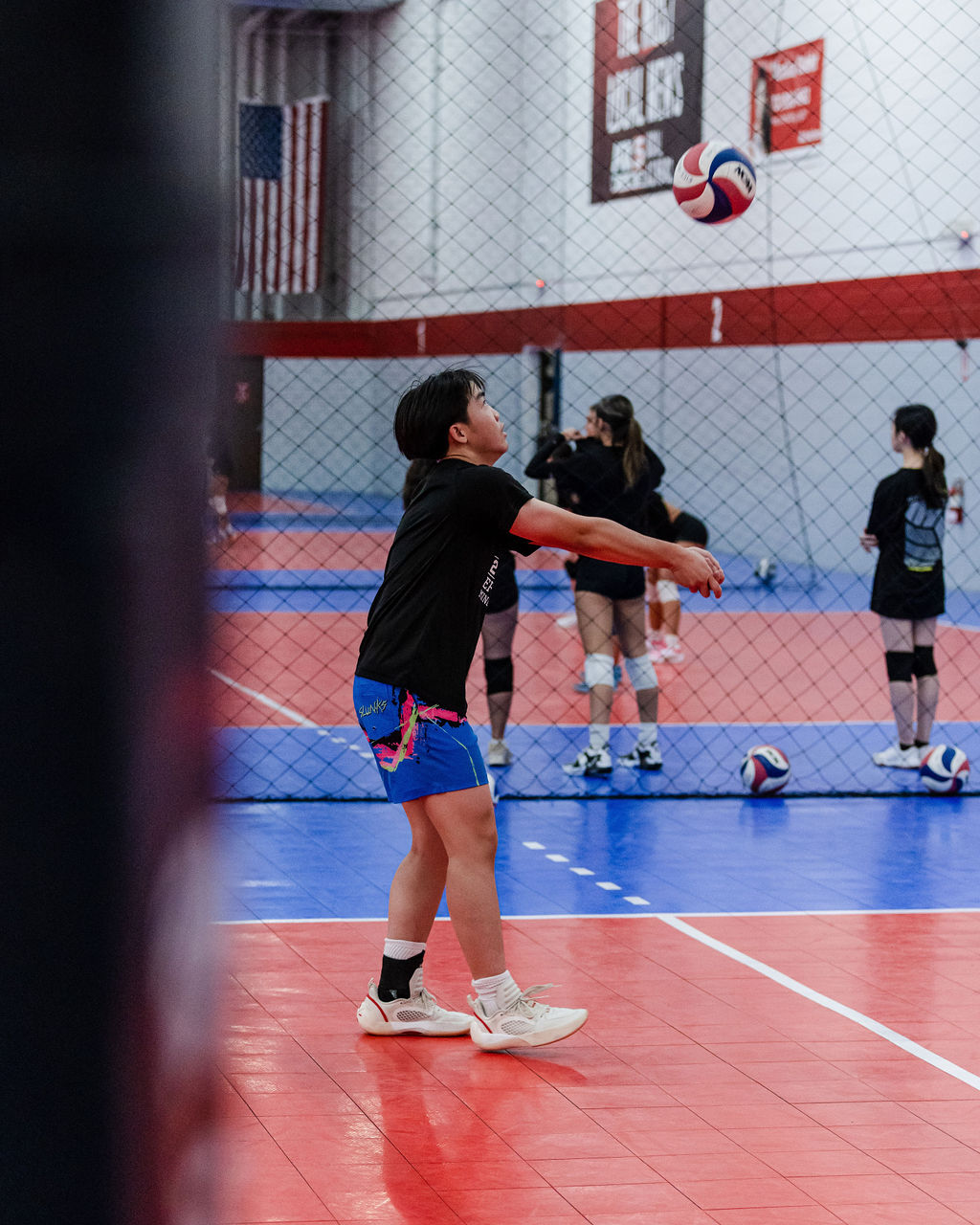 The forearm pass, also known as a bump or pass, is a fundamental skill in volleyball used to receive an opponent's serve or pass the ball to a teammate.
It involves using the forearms to control and direct the ball to the desired target.
The forearm pass, also known as a bump or pass, is a fundamental skill in volleyball used to receive an opponent's serve or pass the ball to a teammate.
It involves using the forearms to control and direct the ball to the desired target.Q: What is a forearm pass in volleyball?
A: The forearm pass, also known as a bump or pass, is a fundamental skill in volleyball used to receive an opponent's serve or pass the ball to a teammate.
It involves using the forearms to control and direct the ball to the desired target.
I like to work on this 3 person "Dodgeball" drill where the person in the middle has to choose which side to get their midsection out of the way of the oncoming ball that's being tossed at their chest before they present their passing platform with an angled shoulder positioned towards the target.
Q: How do I improve my forearm pass in volleyball?
A: Here are some tips to improve your forearm pass:
1. Keep your elbows straight to create a flat platform.
2. Track the ball from the server's hands to anticipate its path.
3. Keep your arms together when contacting the ball.
4. Keep both feet on the ground for better stability.
5. Quickly position yourself behind the ball with proper footwork.
Q: How important is forearm pass in volleyball?
A: The forearm pass is an essential skill in volleyball as it is often the first contact when receiving the opponent's serve.
A good forearm pass sets up the team's offensive play, allowing for better control and accuracy in setting up attacks. It is crucial for maintaining ball control and initiating successful plays.
Q: What equipment can help improve forearm passing?
A: Volleyball forearm passing sleeves are popular accessories used by players to protect their wrists, forearms, and elbows during passing and digging.
Brands like Mizuno and Nike offer volleyball passing sleeves (ad) that can enhance comfort and support while practicing or playing.
Q: Can I practice forearm passing on my own?
A: Yes, you can practice forearm passing on your own. You can perform passing drills against a wall, focusing on technique and accuracy.
Another option is to recruit a partner to practice passing back and forth, simulating game-like situations. Consistent practice and repetition will help improve your forearm passing skills.
Here are some volleyball drills for youth that you can do at home or in practice with a friend or teammate you are working out with at home or on their own or even during an open gym at your school.
Watch as Kenny and Jaylen work on controlling the ball to a consistent spot on the wall and then control the ball to themselves, then finally they control the ball to each other...repeatedly.
Q: Are there any specific drills I can do to improve my forearm passing?
A: Yes, here are a few drills you can try:
1. Wall Passing Drill:
Stand facing a wall and practice passing the ball against it. This helps improve technique and control.
2. Triangle Drill:
Set up three cones in a triangle shape and practice moving quickly between them while passing a ball. This improves footwork and positioning.
3. Pass and Move:
Set up a designated area and practice passing the ball with a partner while moving around. This simulates game-like movement and improves passing accuracy under different conditions.
My tips on How to do wall passing drills...
Volleyball wall passing and wall setting drills can be done daily at home with a goal of at least 250 - 500 reps of various drills to keep your
- passing or setting technique,
- angled platform work,
- ball contacting skills and
- control of the ball.....extremely sharp!
Pick a brick, a specific spot on the wall or mark a big X in chalk on a wall or use a basketball net or backboard ...no matter what you decide to use as your target... anybody walking by.... should be able to see exactly where the spot is that you are aiming for EVERY...single....time .
Do 3 to 5 sets of 100... five feet from the wall ....then side step two feet and repeat. Then step back and repeat.
Complete 300 to 500 passing repetitions
Q: What should I do if I struggle with forearm passing accuracy?
A: To improve your forearm passing accuracy, focus on the following:
1. Proper hand contact:
Make sure to contact the ball with the forearms, slightly above the wrists, creating a solid platform.
2. Eye on the ball:
Keep your eyes on the ball as you pass it, maintaining visual contact throughout the entire process.
3. Controlled body position:
Maintain a balanced and athletic stance with your feet shoulder-width apart, knees slightly bent, and weight forward.
Q: How can I generate more power in my forearm pass?
A: To generate more power in your forearm pass, consider the following techniques:
1. Use your legs:
Engage the muscles in your legs and core to generate power from the ground up. Bend your knees and use a slight upward thrust to add strength to your pass.
2. Follow-through:
After making contact with the ball, continue your arm extension forward and slightly upward. This follow-through motion adds power and accuracy to your pass.
3. Timing and anticipation:
Anticipate the ball's trajectory and aim to meet it at the highest point of its arc for maximum power.
Q: What should I do if the ball is coming at me too fast for a forearm pass?
A: If the ball is coming at you too fast for a forearm pass, you can use an alternative technique called the overhead pass or "volley." In this method, you use your fingertips to guide the ball, creating a controlled trajectory. However, mastering forearm passing should still be a priority, as it is the most effective and commonly used pass in volleyball.
Q: How can I develop good forearm pass footwork?
A: To develop good footwork for forearm passing, try the following:
1. Quick first step:
React quickly as soon as you see the server make contact with the ball. Take a small, explosive step towards the anticipated ball trajectory.
2. Shuffle and adjust:
Maintain proper balance and shuffle your feet to adjust your position as needed. This allows you to align yourself behind the ball and maintain stability.
3. Practice positioning drills:
Set up cones or markers on the court to simulate different serve placements. Practice moving quickly and efficiently to each marker, assuming the correct forearm pass position behind it.
If your athlete struggles with consistent serve receive, gets subbed out, or is overlooked for playing time—this is the fix you’ve been looking for.

Struggling with passing consistency?
I help talented passers tired of getting pulled from games because of inconsistent serve receive skills BUILD passing confidence without expensive private lessons using the same 3-step system that's helped dozens of my athletes get recruited.
Download my eBook for $17.99 and start building the passing confidence that keeps you on the court—and gets you seen by college coaches.
From Lady Vol to Legend: Coach April Produces Powerful Passionate Players...is that you?
What Are You Looking For?
Click to Download Your Pre Serving Ritual Mastery Checklist pdf:
🎯Volleyball Pre Serving Ritual Guide -
Players! Learn How To Transform Your Serve from Weak to Weapon
Click to Download Your Parent's Volleyball Serving Checklist pdf
🎯Parent's Volleyball Serving Checklist Guide
Parents! Help Your Player Develop Championship Serves (Even If You've Never Played)

Hi there!
Thanks for stopping by. Hope you learned something today that will help you reach your volleyball goals.
Be sure to subscribe to my email newsletter so you can learn more each week!
Stay strong! Stay motivated!
-Coach April

SUSCRIBE to my email newsletter below!
 Click to learn more about the weekly volleyball classes and clinics or email info@imrpoveyourvolley.com for information
Click to learn more about the weekly volleyball classes and clinics or email info@imrpoveyourvolley.com for informationCongratulations to my seven Boys-18s Vegas Volley club players who played in two state championship finals yesterday, the 3A and 5A State champinship finals at Sunrise Mountain High School.
TOURNAMENT CHAMPIONS!
A-1 Vegas Volley VBC
In It To Win It Tournament
May 2 - 4, 2025 Tournament
Gold Medalists
18s Premier Division
Vegas Volleyball's Unsung Heroes: Celebrating Moms with Peace Love Volleyball Shirts
Ready to energize your volleyball mom journey?
Subscribe to my 'Producing Powerful Passionate Peaceful Players' email list above on ImproveYourVolley.com.
You'll receive energy-boosting tips, exclusive insights from me, Coach April Chapple on maintaining momentum in volleyball.
Let's power up the Vegas volleyball scene together!
Recent Articles
-
3 Exercises To Improve Spike Skills By Hitting With A Faster Armswing
Jan 06, 26 01:13 AM
These 3 volleyball exercises to improve spike skills by hitting more balls in the court with a quick armswing and aggressive spike approach to beat blockers. -
Your Serve in Volleyball: 10 Tips To Get You From Bench to Starter
Jan 02, 26 03:41 PM
I hold Tennessee's #2 career aces record (244 aces). Last month I coached 7 players to state finals. These 10 serving tips separate legends from bench players. -
Overhand Jump Serve Volleyball Tips To Score Many More Points and Aces
Jan 02, 26 03:14 PM
My "Coach April Overhand Jump Serve Volleyball Tips" designed to help you increase your serving accuracy, power and the ability to serve more aces in volleyball.
